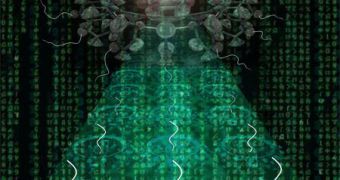Stop looking for the most powerful computer in the world, you've already found it long ago, but are just not aware of it. We might not have the greatest memory to help us, however when it comes to processing power, our own brain is the ultimate computational machine. No wonder that computer processor designers are turning more and more to brain-like chip structures. Just recently, there has been developed such a device, capable of completing 16 times more operations than a regular computer transistor, opening the way to potential processing units 1,000 times faster than a transistor.
Forget about creating powerful computers, how about some androids or nanits, microscopic robots capable of infiltrating biologic structures to serve us as doctors when the immune system fails to help. The research was conducted by artificial intelligence and molecular electronics scientist from the National for Materials Science At Tsukuba, Anirban Bandyopadhyay, on a compound known as duroquinone, having a molecule similar to a hexagonal plate with four cones on it.
The duroquinone molecule is less than a nanometer in diameter, meaning that it is a hundred times smaller than the smallest wavelength of visible light. With the help of 17 such duroquinones, a machine of 16 molecules can be created around a single molecule, placed on a gold surface. The four cones can be moved around the hexagonal shape by applying sharp electrical pulses to the extremes in relation to the center duroquinone. The molecules can then move relatively easy once the duroquinones at their extremes have been moved from their original position.
By having only one duroquinone as a central reference point, instructions can then be sent simultaneously to the other 16 duroquinones. According to Bandyopadhyay, the design of the small cybernetic brain is based on the workings of a true biological one. Because it is able to hold four different states, thus four digits, a single central molecule with 16 other duroquinones could theoretically result in up to 4.3 billion outcomes per pulse.
Traditional computers using bipolar transistors have the disadvantage of only being able to process information in the binary code, meaning the transistor can only have two states, whether a '0' - switch open or a '1' - switch closed, or two logical outcomes.
The advantage of using duroquinones molecules is that they can be used in a variety of applications, not only for computer chips, such as microscopic motor, propellers and so on. However, there is a small problem. Not small, rather big, as big as a scanning tunneling microscope needed to provide with the electrical signal required to move the molecules inside the microscopic structure. Bandyopadhyay argues that this can be solved with the help of molecules, delivering the electric pulses instead of the tunneling microscope.
Although constructed at temperatures of only -193 degree Celsius, the device can then be operated at room temperature. The team's next goal is to expand it from 16 duroquinones to a sphere of 1,024 duroquinones, a device which could execute up to 1,024 instructions, with 4^1024 possible outcomes - 1 followed by 1,000 zeros.

 14 DAY TRIAL //
14 DAY TRIAL //